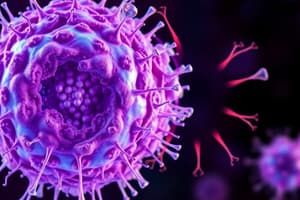Podcast
Questions and Answers
What are prokaryotic cells?
What are prokaryotic cells?
Very simple cells that do not contain a nucleus or other membrane-bound organelles.
What are eukaryotic cells?
What are eukaryotic cells?
More complex cells that contain a nucleus and other membrane-bound organelles.
What is the function of the nucleus?
What is the function of the nucleus?
The control center of the cell that contains DNA.
What begins in the nucleolus?
What begins in the nucleolus?
Signup and view all the answers
What is the role of the nuclear membrane?
What is the role of the nuclear membrane?
Signup and view all the answers
Where are proteins assembled in the cell?
Where are proteins assembled in the cell?
Signup and view all the answers
What distinguishes rough ER from smooth ER?
What distinguishes rough ER from smooth ER?
Signup and view all the answers
What is the function of the Golgi body (apparatus)?
What is the function of the Golgi body (apparatus)?
Signup and view all the answers
Where does photosynthesis take place?
Where does photosynthesis take place?
Signup and view all the answers
What is the primary function of mitochondria?
What is the primary function of mitochondria?
Signup and view all the answers
What is the function of the cell wall?
What is the function of the cell wall?
Signup and view all the answers
What does the cell membrane do?
What does the cell membrane do?
Signup and view all the answers
What are cilia?
What are cilia?
Signup and view all the answers
What are flagella?
What are flagella?
Signup and view all the answers
Study Notes
Cell Types
- Prokaryotic cells are simple, lack a nucleus and membrane-bound organelles.
- Eukaryotic cells are more complex, containing a nucleus and various membrane-bound organelles.
Nucleus and Related Structures
- Nucleus serves as the control center of the cell, housing DNA.
- Nucleolus is the site where ribosome assembly begins.
- Nuclear membrane separates nuclear contents from the cytoplasm and regulates material passage.
Protein Synthesis
- Ribosomes are the sites of protein assembly, utilizing DNA instructions.
- Endoplasmic Reticulum (ER) consists of:
- Rough ER involved in protein assembly and transport.
- Smooth ER responsible for lipid assembly and transport.
Golgi Apparatus
- Golgi Body modifies, sorts, and packages proteins from the ER for storage or transport outside the cell.
Energy Conversion Organelles
- Chloroplasts carry out photosynthesis, converting light energy into chemical energy.
- Mitochondria are the powerhouses of the cell, performing cellular respiration to produce ATP from food-derived chemical energy.
Cell Structure
- Cell wall provides structural support, protection, and shape to the cell, mainly found in plant cells.
- Cell membrane acts as a selective barrier, regulating the entry and exit of substances.
Movement Structures
- Cilia are short, hair-like projections that facilitate movement.
- Flagella are longer, whiplike projections used for motility.
Studying That Suits You
Use AI to generate personalized quizzes and flashcards to suit your learning preferences.
Description
This quiz explores the fundamental differences between prokaryotic and eukaryotic cells, focusing on their structure and organelles. Each flashcard provides concise definitions to help reinforce your understanding of these essential biological concepts.




